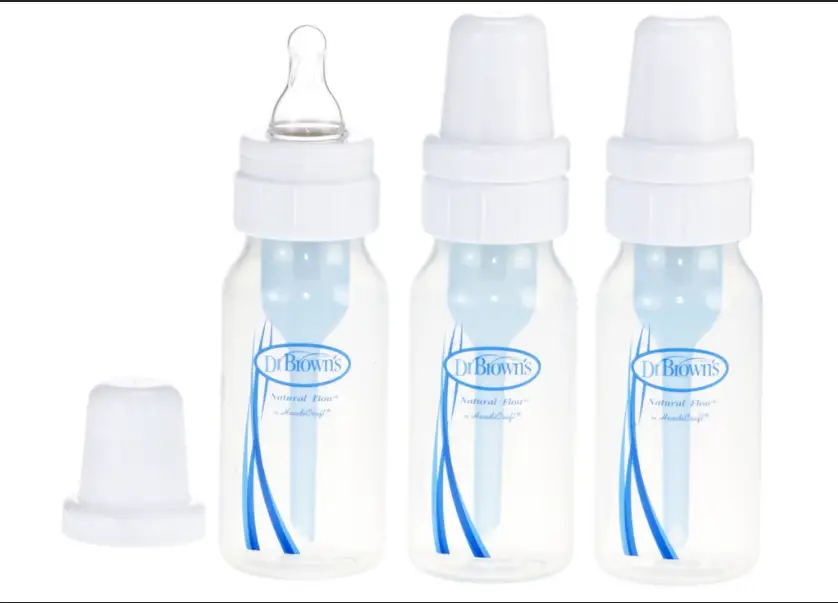As a parent, feeding your baby is one of your top priorities. But this might be a struggle if your baby has colic or related health issues. You would need to get a baby feeding bottle to reduce the pain and enable your baby to eat without much fussiness. Dr. Brown’s bottles have been used since 1996 and they are specially designed to help lessen the pain of colic or related health issues so your baby can feed with comfort and without a fuss. Dr. Brown’s bottles come with a vent system that allows your little one to feed without having the issue of vacuuming or ingesting air bubbles. This would prevent spit-ups burping and gas. Although, the vent in Dr brown’s bottles is very helpful for smaller babies who tend to swallow a lot of air and get gassy afterward, as your little one becomes older they begin to have fewer issues with gas and might not need the vent anymore.
Hey! By the way… any links on this page that lead to products on Amazon are affiliate links and I earn a commission if you make a purchase. Thanks in advance – I really appreciate it! .
Does the vent in Dr. Brown’s bottle work?
Traditional baby bottles allow for air to be ingested by babies which results in fussiness, discomfort, and symptoms associated with colic. However, Dr. Brown’s baby bottle does not allow for air to be ingested by your baby. When you are feeding your baby, your baby sucks the breast milk from the bottle through the teat. When the breast milk leaves the bottle, the air enters through the vent. The vent allows the air to enter and directs it to the area above the liquid keeping the air and the liquid in different places because the air and liquid are separate. Thus, your baby can feed without ingesting air while feeding. Your little one would have a great feeding experience using Dr. Brown’s baby bottle with an internal vent system.
The question on the minds of some parents might be how to know when to stop using vent on Dr Brown’s bottles for your little one. Below is a guideline that would help you to know when to stop using the vent in Dr Brown bottles to feed your baby.
When to stop using vent on Dr. Brown’s bottle
Babies are different and might grow out of colic differently although most babies grow out of colic at about 3-4 months of age. Dr. Brown’s option+ bottle can be used with or without the venting system. Removing the vent can be done when your baby’s feeding becomes developed or when your little one does not show signs of pain, burping, and fussiness. A baby’s digestive system is usually the last to get fully developed, hence the need to use the venting system until you notice an improved feeding habit in your little one.
Below are a few signs to take note of before you stop using the venting system in Dr Brown’s bottle.
Signs to look for to know When To Stop Using Vent On Dr Brown’s Bottles
- When your baby can sit up or move around without help: Usually around 4-6 months of age, babies would tend to sit on their own and this gives them the ability to get comfortable to burp on their own even when they ingest too much air and gas bubbles during feeding. When your baby moves around, it also helps to push these air bubbles out faster. Therefore, your little one might not need to use the vent in Dr Brown’s bottle.
- When your baby starts taking solid food: When your baby’s digestive system develops and you begin to introduce solid food, your little one becomes less uncomfortable with the gas bubbles formed while breastfeeding since the digestive system can handle more food intake. At this stage, you can stop using the vent in Dr Brown’s bottle.
- No sign of gassiness, fussiness or colic: You can remove the vent during a feeding period to see if your baby still gets fussy or cries from gas pain. If you notice that your baby does not make a fuss or does not cry from gas discomfort, you can fully remove the vent in Dr Brown’s bottle.
Does Dr. Brown’s bottle leak without the vent?
Dr. Brown’s baby bottles come in different options. There is Dr. Brown’s natural flow bottle which comes with a blue vent. This type of vent creates 100% vacuum free feeding and cannot be removed. Hence, the bottle cannot be used without the blue vent in place and could result in a leakage. However, there is Dr. Brown’s option+ bottle which has a green vent and can be used with or without the vent without any leakage. Some parents find removing the vent more suitable when their little one’s feeding becomes developed and would no longer require the use of a vent. Dr. Brown’s option+ bottle is the best option if you would still want to use the bottle when your baby’s feeding develops and you want to continue using the bottle to feed your baby. Below are few ways to ensure that the Dr. Browns bottle does not leak without the vent.
- Ensure that you do not overfill the bottle so there won’t be any pressure or leakage. If your baby is on formula, you can fill in the formula first to avoid overfilling the bottle.
- Do not overtighten or under tighten the bottle: When you over tighten the bottle, it could cause a buildup of pressure and this could leak out during feeding. Also, when you under tighten the bottle, the milk can leak out through open space that is not closed properly.
When babies suck the breast milk from the bottle, air could be ingested and this might cause pain due to the gas bubbles formed. Dr Brown’s bottle is designed to help reduce the pain and fussiness caused by ingesting air with the venting system in the bottle. At some point, your baby would need to stop using the vent in Dr Brown’s bottle. The above guideline would help you know when you should stop using the vent in Dr Brown’s bottle, signs to take note of before you stop using the vent, and how to ensure that the bottle does not leak without the vent.
More reasons why do Dr Brown bottles leak?
Do you have Dr. Brown bottles that leak? If yes, then be ready to get the issue resolved. Now, there are four different things that can cause dr brown’s bottles to leak and they are:
a. If the vent part of the bottle is wet from washing with water, it will leak
b. If you warm up the bottle with the ventilation system in it, it will cause it to rise and then leak during feeding
c. If the cap does not screw on properly, evenly, and tight, it will leak
d. If you put in more formula milk than required, Dr. Brown’s bottle will leak
So to correct the issue of Dr. Brown’s bottles leaking, ensure you don’t leave water in the vent part of the bottle after washing. Don’t warm the bottle with the vent inside and screw the cap properly so that it does not leak.
Dr brown bottles leak when shaken
If you shake the bottle with the vent in it, and milk enters into the vent, the bottle will leak. So to prevent leakage caused by shaking, take off the nipple after shaking to remove the formula from the vent.
Dr brown bottles leak when traveling
Dr. Brown’s bottles can leak when traveling because of improper positioning. It is recommended you get the Dr. Brown travel disk and ensure the bottle is standing upright to prevent leakages.
Bottles similar to Dr Brown
Bottles similar to Dr. Brown include the MAM bottles, NUK bottles, Avent bottles, and Comotomo bottles Here are two posts on MAM bottles vs Dr. Brown’s bottles and Avent bottles vs Dr. Brown’s bottles. Do check them out.
Dr. Brown vent turning yellow
When Dr. Brown’s vent turns yellow, it is a sign of clumped-up formula that you did not wash well. If you are not ready to replace them, use the Cascade dishwashing detergent and the little brush that comes with the bottles to clean in between the holes in the plastic top and in the tube. It will make them look very clean without the yellow colour.
When To Stop Using Vent On Dr Brown’s Bottles?
Wondering about when to stop using vent on Dr Brown’s bottles? There are signs that can help you to know the right time. This includes when the baby grows out of colic at about 3-4 months of age; when your baby’s feeding becomes developed; when your little one does not show signs of pain, burping, and fussiness, etc. Above all, you may want to consult with your Pediatrician to know the right timing.

